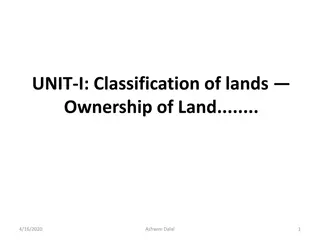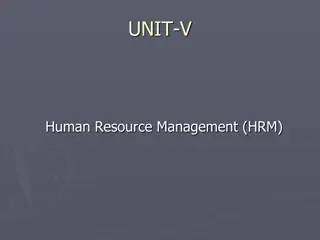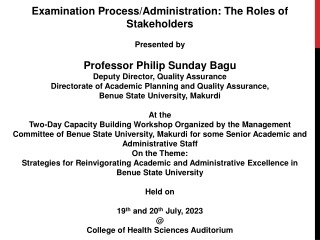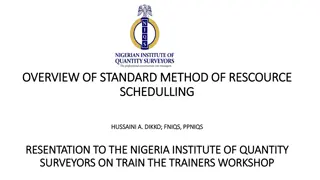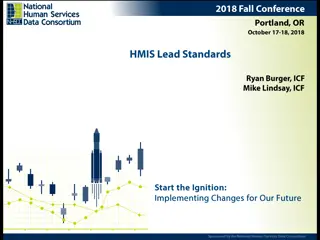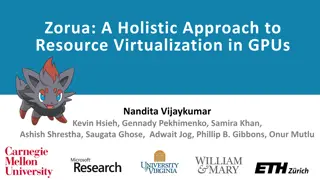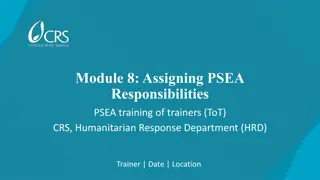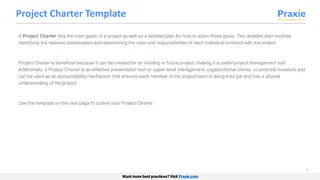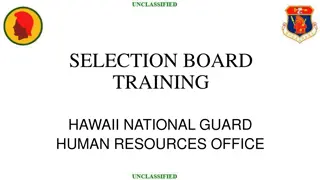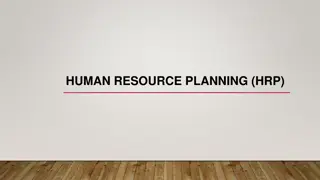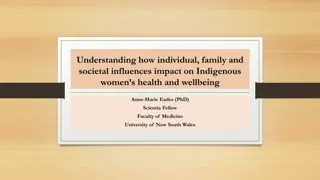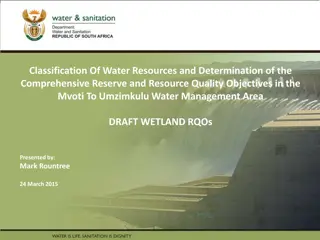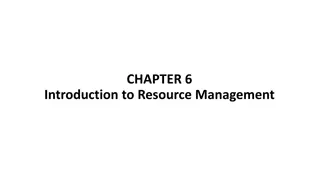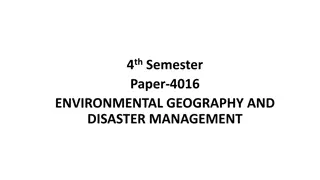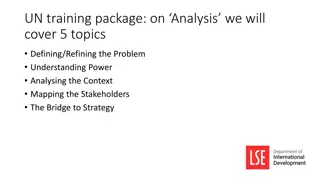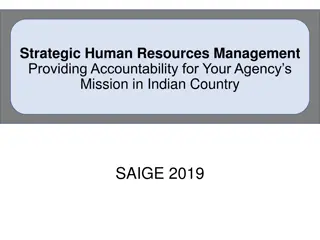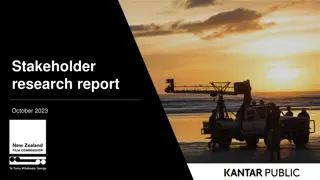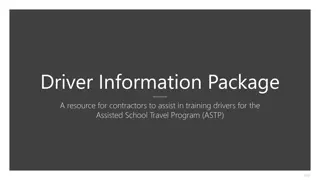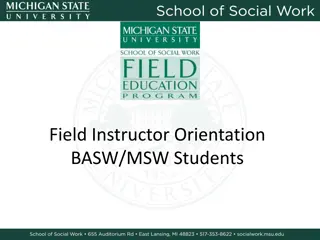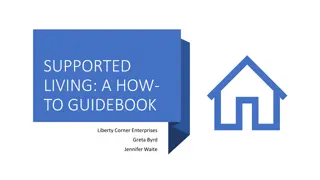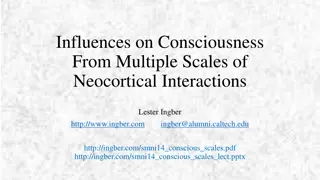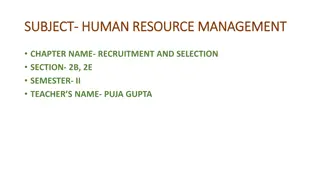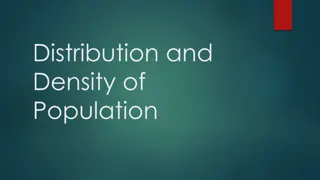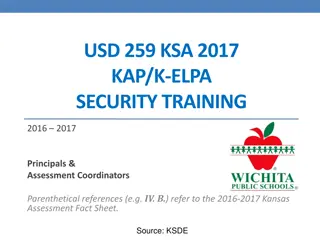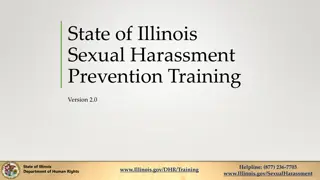Key Influences on Human Resource Management Stakeholders and Responsibilities
Key influences on human resource management encompass stakeholders, legal framework, economic, social, technological, ethics, and corporate responsibility. Stakeholders involve various groups with interests such as employers, employees, unions, government, and shareholders. Employers seek flexibility and productivity, while employees focus on fair treatment, training, and job security. These key influences shape the HR processes and relationships in organizations.
Download Presentation

Please find below an Image/Link to download the presentation.
The content on the website is provided AS IS for your information and personal use only. It may not be sold, licensed, or shared on other websites without obtaining consent from the author. Download presentation by click this link. If you encounter any issues during the download, it is possible that the publisher has removed the file from their server.
E N D
Presentation Transcript
Key influences on Human Resource Management
There are six key influences to consider. Stakeholders Legal framework Economic Social Technological Ethics and corporate responsibility
Stakeholders A number of people, groups and institutions have a stake or interest in what happens in the human resource process. Obviously the employer and employee have a vital interest. The employee is concerned about working conditions and pay. The employer is concerned about productivity and costs, because these will affect the competitive position of the business.
Other groups also have a stake in employment relations. The government, for example, will be concerned if there is discrimination in the workforce. Currently the Federal Government is modernising the award system to make the system simpler. Unions and employer associations have an interest because they represent employees and employers. Shareholders also have a keen interest because issues such as productivity can impact strongly on profitability. Each of these groups is a stakeholder in the human resource process.
Employers The employer is a major stakeholder in the human resource management process. The employer wants to ensure that the employment relations framework: * provides a great deal of flexibility, choice and productivity in working arrangements * allows the primary responsibility for deciding wages and conditions of employment to be in the hands of employers and employees * places the focus on employers and employees managing their workplace relations in the workplace * provides opportunities for businesses to respond to changes in the external environment.
Employees Employees are also major stakeholders in the human resource management process. Employees want to ensure that: * agreements to increase productivity are adequately rewarded * there is appropriate training leading to career opportunities * the workplace is safe and free from harassment and bullying * they have a reasonable degree of job security and are treated fairly.
Employer associations Employer associations represent businesses in a particular industry. Employer associations give bargaining strength to the employer in the industry. They also lobby governments to ensure the employers view is considered when regulations are framed. Employer associations want to ensure: * industry-wide increases in productivity * fair reporting of the employer s view in negotiations.
Unions Unions give bargaining strength to employees. The union is an important stakeholder in the human resource management process. Unions want to ensure that their members: * are fairly paid * work in a safe environment free from harassment and discrimination * receive expert help in negotiating agreements with employers * have a high degree of job security.
Government organisations Government organisations are major stakeholders in the human resource management process. The most important government organisation is Fair Work Australia (responsible for dispute resolution for setting minimum wages and conditions) as well as overhauling the award system. The Federal Government wants to ensure that: * there is sufficient flexibility in employment relations to provide the greatest improvement in productivity, maximum employment and the development of an economy- wide competitive advantage. * the focus of the federal workplace human resource management system is on agreement- making between the employer and the employee. These are called collective agreements and the agreement is achieved through enterprise bargaining between the employer and the employee. * the government achieves its goals through organisationssuch as Fair Work Australia.
Society Society is an often ignored but most important stakeholder in the human resource management process. This is because businesses operate within society and the decisions they make impact on society. The people who own businesses and the people who work in them make up most of society. Decision making in the human resource process influences the availability of goods and services and the prices they are sold at. The decisions made in the human resource management process affect the standard of living and the rate of economic growth and these influence all Australians.
When employees and employers are unable to resolve disputes, society may be inconvenienced by strikes. In the past that was very common but under the Fair Work Act there has been a significant reduction in industrial action.
Complete the table below and outline the responsibilities of each STAKEHOLDER RESPONSIBILITIES Employers Employees Employer associations Unions Government organisations Society
Short answer questions 1. Briefly explain the key difference between stakeholders and share holders. 2. Explain two reasons why some stakeholders are more important than others.
Casestudy Choose one business that you are interested in. Identify the stakeholders of the business Go to the Fair Work Commission. What award would the employees of your chosen business work under? What sorts of things are covered by this award?
Legal - the current legal framework The current legal framework influencing human resource management consists of statute law and common law. The common law refers to laws made by judges in courts. These laws are made as cases go before courts and the courts make a decision. When superior courts make decisions they become precedents that lower courts have to follow. Statute laws are those made by the Parliament. The statute law is the Fair Work Act (Cth) 2009. This legislation established Fair Work Australia as the independent umpire .
Fair Work Australia has established the minimum conditions for employment and deals with things like pay, working conditions, hours of work and holidays on an industry basis in what are called modern awards. Modern awards commenced on January 1 2010 and it is intended that there will be a continuous shift of employees from state awards to the Federal modern awards.
To gain conditions above the award (and there are a large number of workers on the award) employer and employees need to negotiate. Employees want more benefits. Employers want two key things in return for more benefits: they are changes in the way things are done and higher productivity. Negotiations to achieve agreement must be in good faith. Work Place Australia will deal harshly with either employer or employee who fails to negotiate in good faith.
Once an agreement is reached a contract is signed and, if either party breaches that contract, the other can go to the Federal Court to seek compensation for any damage they may have experienced. There will be no industrial action during the term of the agreement. There is a protected period towards the end of an agreement where industrial action such as strikes, lockouts, work to rule, bans and pickets can be employed while the new agreement is being negotiated. However, there are limits on industrial tactics. These include a requirement to give 72 hours notice and to hold a secret ballot on members views of the type of action that could take place. For example, in July 2011 members of the Australian and International Pilots Association gave 287 Qantas pilots permission for a 48-hour strike if the union considered it necessary.
If agreement cannot be reached, Fair Work Australia has skilled employees who can help mediate or arbitrate a new agreement. Mediate is where Fair Work Australia guides both sides to an agreement. Arbitrate is where Fair Work Australia determines the new agreement. Employer and employee negotiate a collective agreement. The negotiation process is often called enterprise bargaining.
In 2010 Fair Work Australia approved more than 800 new agreements that covered just on 900 000 employees. The approval process is important. Under the Fair Work Act there can be no disadvantage in signing the new agreement. There are also common law agreements but these can only apply to employees earning more than $100 000 a year. Where this occurs, as generally in the mining sector of the economy, for example, employers are able to negotiate productivity agreements with individual employees.
The employment contract An employment contract is established when an employee accepts a specific offer of employment (either oral or written). Under this contract, both the employer and employee have certain rights and obligations. Some come from the common law but most are set out in awards, agreements or common law contracts.
The common law provides for a contract of employment (sometimes called a contract of service). The contract of employment is a legally binding agreement between an employer and an employee. The contract sets out such things as how the employee will be rewarded and the work requirements or working conditions of the employee. Professionals such as surgeons and lawyers typically use the common law contract. Contracts of employment may contain provisions for probationary or trial periods on commencement of employment and the employee must be paid during any such period. An employment contract is a formal agreement between an employee and an employer that is legally enforceable by a court.
Although an employment contract is established when an employee accepts a specific offer of employment that can be either oral or written, it is much better to have a written agreement. The written agreement creates certainty. There are no misunderstandings where one party meant something that was misinterpreted by the other party. The typical employment contract will outline the nature of the work, set out the rewards and provide general information such as the hours of work.
Common law (rights and obligations of employers and employees), minimum employment standards, minimum wage rates, awards, enterprise agreements, other employment contracts The common law has established a number of rights and responsibilities of both the employer and the employee. The employer, for example, is required to provide a safe working environment, avoid discrimination and ensure a number of other regulatory requirements such as sick leave, holidays and superannuation contributions. The rights and responsibilities of both employer and employee reflect not only the common law but also a range of statute law where legislation covers the employer -employee relationship. Typical of this legislation is the Fair Work Act 2009 (Cth) , the Occupational Health and Safety Act 2000 (NSW) and the Anti-Discrimination Act 1975 (Cth).
Rights and responsibilities of the employer Both common law and statute law sets out the obligations from the employer to the employee. Obligations are duties or commitments that are legally required of the employer. They include: * to pay correct wages * to reimburse employees for work-related expenses * to ensure a safe working environment suitable for the performance of the employee s duties * to not act in a way that may seriously damage an employee s reputation or cause mental distress or humiliation * to not act in a way that will damage the trust and confidence necessary for an employment relationship * to forward PAYE tax instalments to the Australian Taxation Office * to make appropriate payments under the Superannuation Guarantee legislation.
Rights and responsibilities of the employee Employees also have rights and responsibilities under both the common law and statute law. These include obligations such as: * to obey the lawful and reasonable instructions of the employer * to exercise due care in the performance of the work and to do it competently * to account to the employer for all moneys and property received while employed * to make available to the employer any process or product invented by the employee in the course of employment * to disclose to the employer information received by the employee relevant to the employer s business * to be faithful to the employer s interest (for example, by not passing on to a competitor information about the employer s business or denigrating the employer s products and services).
Each modern award contains the ten minimum employment standards. The modern awards consist of ten key matters such as, for example, penalty rates or sick leave, and these key matters are known as National Employment Standards (NES). The NES are set out in the Fair Work Act and comprise the minimum standards. They are: * Maximum weekly hours of work 38 hours per week * Requests for flexible working arrangements allows parents or carersof a child under school age or of a child under 18 with a disability to request their employer for changed working arrangements that would allow them to meet their family commitments * Parental leave up to 12 months unpaid leave plus the right to request an additional 12 months * Annual leave 4 weeks paid leave per year
* Personal/carers leave 10 days paid * Unpaid Carer s leave 2 continuous days unpaid * Compassionate leave 2 days paid * Community service leave unpaid leave for voluntary emergency activities and up to 10 days paid leave for jury service * Long service leave Fair Work Australia was working on a uniform national long service leave standard in 2011 and it was finalised at that time * Public holidays a paid day off on a public holiday except where reasonably requested to work * Notice of termination and redundancy pay up to 4 weeks notice of termination and 16 weeks of redundancy pay, the actual amount depending on length of service.
Fair Work Australia provides a safety net for workers on the minimum wage. On the 3rd June 2011, for example, Fair Work Australia awarded a 3.4% increase in award wages. This increased the wage by $19.40 to $589.30. Although Fair Work Australia holds annual reviews of the minimum wage, it considers both the needs of workers on the minimum wage and the capacity of businesses to pay an increase. In 2009, for example, there was no increase in the minimum wage at all.
Occupational health and safety and workers compensation Occupational Health and Safety refers to all the procedures put in place to ensure that the workplace is safe for employees and independent contractors. There are both legal and ethical issues involved. Employers have a legal duty to ensure the health, safety and welfare of employees. These duties are set out in the Occupational Health and Safety Act 2000 (NSW).
There is also a concern with some workplace cultures. Sometimes, for example, workers don t wear items of safety equipment, despite the clear instructions of the employer. It is very difficult to change a culture, but employers have an obligation to try. It is interesting to notice the way Orica have approached a safe workplace culture. Go to www.orica.com.au and browse the Orica approach to safety. Write a few points explaining this.
Workers compensation Workers compensation in Australia is a compulsory employer-financed, no fault , occupational disabilities program for work-related injury and disease. Workers compensation refers to the money a worker receives to make up for loss, injury or suffering that follows a work accident. When an accident does occur, it is the employer s responsibility to ensure that the injured worker receives all necessary medical and rehabilitation care and does not suffer loss of income. This is a legal responsibility. The aim is to ensure that the worker is in the same position as if the accident had not happened. This is the ethical aspect.
Anti-discrimination Anti-discrimination has both a legal and ethical dimension. Anti-discrimination refers to measures aimed at stopping unjust or harmful treatment of groups of people on the basis of things like their race, age or gender. It is against the law to discriminate against people on the basis of such things as race, age, disability, gender, sexual preference and so on. The legal issue is set out in legislation such as: * Racial Discrimination Act 1975 * Sex Discrimination Act 1984 * Disability Discrimination Act 1992 * Equal Employment Opportunity Act 1987 However, the ethical dimension is so important because it is difficult to prove discrimination. Employers should not discriminate because it is wrong to do so.
Equal Employment Opportunities (EEO) Equal Employment Opportunities try to provide opportunities to groups of people who may have been denied a fair go in the past. The legal issues are set out in the Affirmative Action (Equal Employment Opportunity for Women) Act 1986 (Cth). This legislation requires large companies with more than 100 employees to report publicly on the number of women in new appointments and promotions. Again, the aim of the legislation is to get senior management to think about what is right.
Economic Economic influences are important in a number of ways. Economic influences refer to changes in the level of spending in an economy. When the economy is booming, employees have greater bargaining power. Often several businesses want their skills. This is the situation currently with the mining boom. Mining businesses are competing to get the limited supply of employees with the skills they need. This is why wages and salaries in the mining sector rose so rapidly after 2010.
On the other hand, if the economy is in recession, the demand for the business s products will fall and it is necessary to reduce staff in order to cut costs. This is why the Australian Government introduced a stimulus package after the 2009 Global Financial Crisis. Every taxpayer received $900 to protect employment in retailing, a great deal of money was spent on school buildings to protect the employment of people in the construction industry and a great deal of money was spent on the installation of ceiling insulation to provide work for low-skilled employees. The program was remarkably successful and Australia s unemployment rates were well below other developed nations that failed to increase government spending to take the place of falling private spending.
In the boom environment employees find it easier to negotiate benefits. Typically there are skill shortages at these times and employers bid against each other to get the skills they need. This forces up the wages and salaries and is what happened during the mining boom. When economic activity declines, the power in the negotiation process shifts to the employer.
Technological Technological changes often have a profound impact on human resource management and their staffing requirements. Walmart, for example, established their dominance in the retailing industry through the technology of bar coding. Walmart was the first business to implement bar coding throughout the business. It meant the business could operate, for example, with just a third of the checkout staff they had before the change.
Walmart are doing a similar thing with radio frequency identification technology (RFID). Moreover, RFID has inspired technology such as near field communication (NFC), that is used in technology such as Google s Wallet and will have a profound effect on human resource requirements. This type of technological change is occurring in every aspect of business and the rate of change is accelerating. Businesses that fail to respond risk losing their competitive advantage in the market place to businesses, like Walmart, that rapidly adopt the technology.
Technological change also impacts on the current human resource management in a business. Changes in technology (the way things are done) often mean employees need to be trained in the new technology. This has implications for liquidity in the short term. Training is expensive. In the long term, adopting a new technology and the training associated with it is likely to improve productivity, lower costs and improve profitability.
Article: Almost 40 per cent of Australian jobs could be replaced by technology by 2025, report finds
Social The changes currently taking place in society are dramatic and they are having a significant influence on employment relations. Social influences on business come from the attitudes, values and beliefs in society. Some of the most important social changes are changing work patterns and changing living standards.
Changing work patterns In the last ten years there has been a significant reduction in full-time work and a dramatic increase in part-time and casual work. This process is called casualisation of the workforce . Australia has one of the most casualised workforces in the developed world.
Significant aspects of current work patterns are: * the disappearance of almost all unskilled jobs from the workplace * considerable increase in the number of women in the workforce * growth in the service industries such as retail, food services, accommodation and travel (the main reason for casualisation). In 2011 about 1.2 million people worked in retailing and this compares with just 250 000 who worked in mining * reduction of workers in manufacturing a steady decline over the last two decades * increased mobility of workers (workers prepared to move from one business to another) * increased numbers of employees working from their homes.
Living standards There is considerable controversy as to the meaning of living standards. In the past living standards were defined in terms of Gross Domestic Product (GDP) per capita. Gross domestic product is the value of the sum total of goods and services produced in Australia in a year. When this figure was divided by the population, it created a per capita, or per person, figure that was regarded as the material living standard. However, the standard of living involves much more than GDP per capita.
Today living standards are measured in terms of the Human Development Indicators (HDI). The human development indicators provide a measurement of standard of living that involves a complex range of factors, including things like longevity, infant and maternal mortality rates, education, crime rates and so on. Increasingly, employees are thinking about an appropriate work-life balance when they negotiate agreements with employers.




